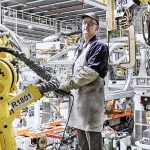Why Portugal’s northern ports are less polluting than you’d imagine
Look at Portugal’s northern ports of Leixões, Viana do Castelo, and traffic on the Douro waterways, you might be forgiven for thinking, due to their industrial nature, that they might be low down the league when it comes to sustainability and green practices.
After all, container ships unloading hundred of TEUs worth of cargo onto quaysides, into warehouses, and then onto the hundreds of lorries that then take their goods on to their final destinations might leave a heavy carbon footprint on the urban environment, right?
Wrong! It might be surprising to learn that of all the transport sectors, maritime shipping is actually the least polluting of all, right down there with rail transport.
Those who attended the Ireland-Portugal Business Network (IPBN) Ocean Conference in Porto in October were enlightened to just how sustainable the industry is, and the measures taken since 2006 to clean up Portugal’s northern ports by the ports authority company that runs them – APDL (Administration for the Ports of Douro, Leixões and Viana do Castelo).
Three magic numbers
On a panel moderated by Pedro Castro Henriques, IPBN member and CEO of Strongstep, Luís Monteiro, Head of the Environment and Energy Efficiency Division at APDL talked about APDL’s experience and strategy on sustainability beginning with three numbers 90, 4 and 6.
“Ninety percent of the goods that we consume in our homes arrive by shipping. If we look at green house gases that are responsible for global warming, the two main culprits are the agricultural and energy sectors, but one-third comes from the transport sector,” he said.
The maritime shipping sector, however, was only responsible for 4% of total emissions.
Most shipping spends most of its time at sea, but a part is docked in ports loading and unloading cargo or undergoing maintenance.
Only 6% of emissions in the transport sector comes from these vessels. This led to three conclusions: 1) Shipping transport is very important for Portugal’s economy 2) Shipping’s contribution to greenhouse gases is small, and 3) the emissions that come from port activities are also low.
That didn’t mean there was no room for improvement . “We’ve got lots to do, are doing a lot and we have a vision for what we want to achieve”, he said, adding: “We have to be a sustainable and resilient port. There is a lot of competition between the ports, and we have had to modernise with new equipment to be competitive”.
New business opportunities
Monteiro added that the closure of the Leça da Palmeira crude oil refinery was a threat, but also an opportunity because energy transition will bring fresh business opportunities.
APDL manages three business areas: the Viana de Castelo port, the Douro waterway covering 200 km, and Leixões port that covers business exploration, conservation, and development; encompassing the competencies and prerogatives of the port authority.
This includes the activities within the port, particularly those regarding the navigation and the state of the vessels in the port, the movement, transport and warehousing of cargo, and activities to do with the maintenance and construction of infrastructures within the port area, and minimising their environmental impacts.
Leixões – an important economic driver
The Port of Leixões caters to around 2,400 ships per year, carrying all types of merchandise including petroleum products, cement, textiles, granites, wines, wood, vehicles, machinery, cereals, containers, scrap metals, iron and steel, as well as other goods.
In 2022 around 14.9 million tonnes of merchandise, 713,00 TEUs (20 TEUs of volume fills one container) were unloaded and to transport all of these good required 474,967 lorries.
Leixões is the most important port in the north of Portugal and deals with the majority of raw materials that arrive from overseas to support Portugal’s industries in the North and centre of the country.
At a later date, manufactured products arrive back at the port to be shipped to overseas markets.
In fact, the port dispatches and unloads goods from around 184 countries worldwide. “The contribution of Leixões is important for Portugal’s GDP as well as for direct and indirect job creation”, said Monteiro.
And Leixões is more than just the loading and unloading terminals. It has two logistics platforms that are an important multi-mode distribution centre in the north of Portugal.
Aiming to be sustainable
The Port of Leixões aims to be a sustainable port. It has been in operation for 130 years, starting off as port for vessels that were too large to navigate the Douro waterways, and then developed into a closed industrial facility. Over time the towns of Matosinhos and Leça swallowed up the area that encompasses the port as they expanded, so that today it is almost impossible to separate out the dividing line between the port, Matosinhos and the town of Leça.
“This is a huge challenge for us, because we have a lot of eyes and ears focused on the port’s activities, and we have a lot of responsibilities on how we manage the environmental aspects of those activities and their environmental impacts, otherwise we’re going to have problems,” explained Luís Monteiro, stressing that it wasn’t just out of some altruistic desire, but rather a vital necessity for the sustainability of the business.
A resilient and competitive port
Monteiro says Leixões aims to be a resilient port since it also has to compete with other national and international ports, including those in Galiza (Northern Spain), as well as other Portuguese ports such as Aveiro, Figueira da Foz, and Sines. “If we weren’t modernising and keeping up with the latest technology and trends, we would be challenged and lag behind.”
But being resilient did not mean resisting changes in the market, but rather adapting to changes, with investments made on modernising facilities and machinery, as well as business diversification.
The Leça crude oil refinery closed in 2021 – owned by Galp Energia, the company permanently ceased oil refining operations at subsidiary Petrogal’s 110,000 m2 refinery in Matosinhos and Leça da Palmeira – because of the company’s new energy transition policies. Monteiro said that the port could not just view the closure as a threat, but rather embrace it as a business opportunity. The new green fuels such as green hydrogen would be the business of the future.
Monitoring environmental impacts
In order to monitor and evaluate the impacts on the environment, the APDL has implemented an Environmental Monitoring Plan and Luís Monteiro said that since 2006 there had been an ongoing improvement in environmental performance of the port, particularly regarding air, water and sediment quality. The plan involves all of the stakeholders and companies that use the port.
The decarbonisation of port activities is one of the APDL’s top priorities and recently it announced an ambitious plan to be the first port with zero emissions by 2035, designing a ‘road map’ on how it would achieve its sustainability goals.
The roadmap for the energy transition and decarbonisation plan currently being developed with the assistance of external experts, has two main sections: diagnosis and action plan.
The first has already been concluded, and makes an overall analysis of all the port’s emissions and energy consumption, including the port infrastructure, equipment, operations and road traffic and maritime activities. The diagnosis was made as a joint effort, consulting with all stakeholders connected to the APDL.
The second part is the action plan, including concrete measures, and a respective schedule.
Here the APDL is very active in order to achieve carbon neutrality by 2035. It is an ambitious goal, since it implies anticipating carbon neutrality 15 years compared to other timelines, and focuses on several fronts, leading the port community, changing the type of energy consumed to sustainable sources, developing multimodal logistic solutions at its facilities, cooperating with municipal councils, efficiently managing the port territory, and reducing the impact of port mobility and operations.
Among the measures being undertaken by the APDL include reducing the time it takes to manage the cargo. Reducing the time taken to handle a container, meaning direct environmental gains, since the lorries would spend less time in port, simplifying bureaucratic procedures, coordinating with public authorities (phytosanitary control, customs, etc.) and finding solutions to speed up cargo handling.
It is also about working with new technology that will allow the digitalisation of port activities, helping to improve the traffic flow (a new road was built bypassing urban residential and commercial areas), better predicting the arrival of cargo, preparing for potential disruptions, and avoiding situations that could have repercussions for Matosinhos.










